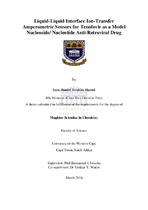Liquid-liquid interface ion-transfer amperometric sensors for tenofovir as a model nucleoside/nucleotide anti-retroviral drug
Abstract
Amperometric sensors for Tenofovir, a model nucleotide/ nucleoside reverse transcriptase inhibitor ARV drug, were studied based on the principle of ion-transfer electrochemistry at the membrane-stabilized oil/ water interface (O||W) in a four-electrode cell set-up. Solutions of the hydrophobic salts tetradodecylammonium tetrakis(4-chlorophenyl) borate (ETH500), ethyl violet tetraphenylborate (EthVTPB), tetrabutylammonium tetraphenylborate (TBATPB), tetraphenylphosphnium tetraphenylborate (TPphTPB) and three ionic liquids
(Methyltrioctylammonium bis(trifluoromethyl sulfonyl)imide (IL1), 1-butyl-3-
methylimdazolium bis(trifluoromethyl sulfonyl)imide (IL3) and 1-propyl-3- methylimdazolium bis(trifluoromethylsulfonyl)imide (IL4)) in nitrobenzene (NB), 1,2-
dichloroethane (DCE), and 2-nitrophenyloctyl ether (NPOE) were each tested as O-phases. The cyclic voltammograms of the resulting O||W interfaces in aq. Li2SO4 or aq. MgSO4 were compared with respect to noise, potential window, and other parameters. The three ILs were also tested as self-sufficient salts without a solvent medium. In the end, the ETH500/ DCE salt/ solvent pair was found to yield the best behaved polarizable O||W interface in aq. MgSO4. The analytical characteristics of the resulting sensors to tenofovir without (Ag|ETH500/DCE||) and with the dibenzo-18-crown-6 (Ag|ETH5000/DB18C6/DCE|| in the O-phase were studied with respect to the two pairs of peaks in the CV, namely the WO ion transfer peak and the reverse OW peak. Both sensors exhibited operational stability of 90 min. After consideration of reasonable S/N ratio and sample throughput rates, the scan rate of
25 mV/ s was used in subsequent signal interrogation with CV. The final potential windows were 0.95 V wide for Ag|ETH500 (10 mM)/ DCE|| in aq. MgSO4 (50 mM) and 0.70 V wide for Ag|ETH500 (10 mM)/ DB18C6 (50 mM)/ DCE|| in aq. MgSO4 (50 mM). From plots of peak currents versus square of scan rate, tenofovir diffusion coefficients of about 2.48 × 10-11 cm2/ s were estimated, which indicated diffusion through the supporting membrane as the rate limiting process. Based on WO ion transfer peaks, the first one exhibited a detection limit of about 5 M, a linear range of 15 – 100 M, and sensitivity of 7.09 nA M-1 towards tenofovir, whereas for the second one these were respectively 3 M, 6.32 nA M-1, and 9 –
100 M. In this way, a four-electrode amperometric detection of ion transfer process at liquid | liquid interface, both under simple and ionophore-facilitated mode, has been demonstrated as promising for analysis of tenofovir as a representative of the nucleotide/ nucleoside reverse transcriptase inhibitor ARV drugs

